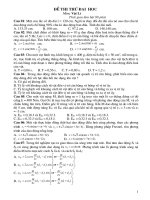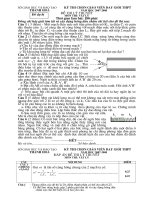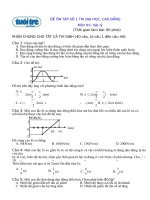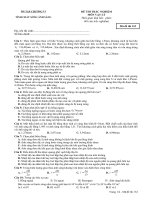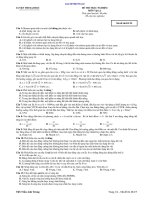Đề thi (4) olympic môn vật lý
Bạn đang xem bản rút gọn của tài liệu. Xem và tải ngay bản đầy đủ của tài liệu tại đây (134.74 KB, 6 trang )
39th International Physics Olympiad - Hanoi - Vietnam - 2008
Theoretical Problem No. 3
CHANGE OF AIR TEMPERATURE WITH ALTITUDE,
ATMOSPHERIC STABILITY AND AIR POLLUTION
Vertical motion of air governs many atmospheric processes, such as the formation of
clouds and precipitation and the dispersal of air pollutants. If the atmosphere is stable,
vertical motion is restricted and air pollutants tend to be accumulated around the
emission site rather than dispersed and diluted. Meanwhile, in an unstable atmosphere,
vertical motion of air encourages the vertical dispersal of air pollutants. Therefore, the
pollutants’ concentrations depend not only on the strength of emission sources but also
on the stability of the atmosphere.
We shall determine the atmospheric stability by using the concept of air parcel in
meteorology and compare the temperature of the air parcel rising or sinking adiabatically
in the atmosphere to that of the surrounding air. We will see that in many cases an air
parcel containing air pollutants and rising from the ground will come to rest at a certain
altitude, called a mixing height. The greater the mixing height, the lower the air pollutant
concentration. We will evaluate the mixing height and the concentration of carbon
monoxide emitted by motorbikes in the Hanoi metropolitan area for a morning rush
hour scenario, in which the vertical mixing is restricted due to a temperature inversion
(air temperature increases with altitude) at elevations above 119 m.
Let us consider the air as an ideal diatomic gas, with molar mass
μ
= 29 g/mol.
Quasi equilibrium adiabatic transformation obey the equation , where
constpV
γ
=
p
V
c
c
γ
= is the ratio between isobaric and isochoric heat capacities of the gas.
The student may use the following data if necessary:
The universal gas constant is
R
=
8.31 J/(mol.K).
The atmospheric pressure on ground is
0
p
=
101.3 kPa
The acceleration due to gravity is constant,
g
=
9.81 m/s
2
The molar isobaric heat capacity is
7
2
p
c= R for air.
The molar isochoric heat capacity is
5
2
V
c= R for air.
1
39th International Physics Olympiad - Hanoi - Vietnam - 2008
Theoretical Problem No. 3
Mathematical hints
a.
(
)
()
11
ln
dA Bx
dx
A
Bx
ABx B ABx B
+
==
++
∫∫
+
b. The solution of the differential equation =
dx
A
xB
dt
+ (with A and B constant) is
() ()
1
B
xt x t
A
=+ where
(
)
1
x
t is the solution of the differential equation =0
dx
A
x
dt
+ .
c.
1
1lim
x
x
e
x
→∞
⎛⎞
+=
⎜⎟
⎝⎠
1. Change of pressure with altitude.
1.1. Assume that the temperature of the atmosphere is uniform and equal to .
Write down the expression giving the atmospheric pressure as a function of the
altitude .
0
T
p
z
1.2. Assume that the temperature of the atmosphere varies with the altitude according
to the relation
(
)
(
)
0Tz T z
=
−Λ
where is a constant, called the temperature lapse rate of the atmosphere (the vertical
gradient of temperature is - ).
Λ
Λ
1.2.1. Write down the expression giving the atmospheric pressure as a
function of the altitude .
p
z
1.2.2. A process called free convection occurs when the air density increases with
altitude. At which values of does the free convection occur? Λ
2. Change of the temperature of an air parcel in vertical motion
Consider an air parcel moving upward and downward in the atmosphere. An air
parcel is a body of air of sufficient dimension, several meters across, to be treated as an
independent thermodynamical entity, yet small enough for its temperature to be
considered uniform. The vertical motion of an air parcel can be treated as a quasi
adiabatic process, i.e. the exchange of heat with the surrounding air is negligible. If the
air parcel rises in the atmosphere, it expands and cools. Conversely, if it moves
downward, the increasing outside pressure will compress the air inside the parcel and its
temperature will increase.
As the size of the parcel is not large, the atmospheric pressure at different points on
2
39th International Physics Olympiad - Hanoi - Vietnam - 2008
Theoretical Problem No. 3
the parcel boundary can be considered to have the same value
(
)
pz, with - the
altitude of the parcel center. The temperature in the parcel is uniform and equals to
z
(
)
parcel
Tz, which is generally different from the temperature of the surrounding air
(
)
Tz. In parts 2.1 and 2.2, we do not make any assumption about the form of T(z).
2.1. The change of the parcel temperature
p
arcel
T with altitude is defined by
parcel
dT
G
dz
=− . Derive the expression of (T, TG
parcel
).
2.2. Consider a special atmospheric condition in which at any altitude
z the
temperature of the atmosphere equals to that of the parcel
T
p
arcel
T ,
(
)
(
)
parcel
Tz T z= .
We use Γ to denote the value of when G
p
arcel
TT
=
, that is
parcel
dT
dz
Γ=−
(with
p
arcel
TT= ).
Γ
is called dry adiabatic lapse rate.
2.2.1. Derive the expression of
Γ
2.2.2. Calculate the numerical value of
Γ
.
2.2.3. Derive the expression of the atmospheric temperature
(
)
Tzas a function
of the altitude.
2.3. Assume that the atmospheric temperature depends on altitude according to the
relation
(
)
(
)
0Tz T z=−Λ, where
Λ
is a constant. Find the dependence of the parcel
temperature
(
)
parcel
Tz on altitude . z
2.4. Write down the approximate expression of
(
)
parcel
Tz when
(
)
0zTΛ<< and
T(0) ≈ T
parcel
(0).
3. The atmospheric stability.
In this part, we assume that changes linearly with altitude. T
3.1. Consider an air parcel initially in equilibrium with its surrounding air at altitude
3
39th International Physics Olympiad - Hanoi - Vietnam - 2008
Theoretical Problem No. 3
0
z , i.e. it has the same temperature
(
)
0
Tz as that of the surrounding air. If the parcel is
moved slightly up and down (e.g. by atmospheric turbulence), one of the three following
cases may occur:
- The air parcel finds its way back to the original altitude , the equilibrium of
the parcel is stable. The atmosphere is said to be stable.
0
z
- The parcel keeps moving in the original direction, the equilibrium of the parcel
is unstable. The atmosphere is unstable.
- The air parcel remains at its new position, the equilibrium of the parcel is
indifferent. The atmosphere is said to be neutral.
What is the condition on for the atmosphere to be stable, unstable or neutral? Λ
3.2. A parcel has its temperature on ground
(
)
parcel
0T higher than the temperature
(
)
0T of the surrounding air. The buoyancy force will make the parcel rise. Derive the
expression for the maximal altitude the parcel can reach in the case of a stable
atmosphere in terms of and Γ. Λ
4. The mixing height
4.1. Table 1 shows air temperatures recorded by a radio sounding balloon at 7: 00 am
on a November day in Hanoi. The change of temperature with altitude can be
approximately described by the formula
(
)
(
)
0Tz T z
=
−Λ with different lapse rates Λ
in the three layers 0 < < 96 m, 96 m < < 119 m and 119 m< < 215 m.
z z z
Consider an air parcel with temperature
(
)
parcel
0T = 22
o
C ascending from ground.
On the basis of the data given in Table 1 and using the above linear approximation,
calculate the temperature of the parcel at the altitudes of 96 m and 119 m.
4.2. Determine the maximal elevation the parcel can reach, and the temperature H
(
)
parcel
TH of the parcel.
H is called the mixing height. Air pollutants emitted from ground can mix with the
air in the atmosphere (e.g. by wind, turbulence and dispersion) and become diluted
within this layer.
4
39th International Physics Olympiad - Hanoi - Vietnam - 2008
Theoretical Problem No. 3
Table 1
Data recorded by a radio sounding balloon at 7:00 am on a November day in Hanoi.
Altitude, m Temperature,
o
C
5 21.5
60 20.6
64 20.5
69 20.5
75 20.4
81 20.3
90 20.2
96 20.1
102 20.1
109 20.1
113 20.1
119 20.1
128 20.2
136 20.3
145 20.4
153 20.5
159 20.6
168 20.8
178 21.0
189 21.5
202 21.8
215 22.0
225 22.1
234 22.2
246 22.3
257 22.3
5. Estimation of carbon monoxide (CO) pollution during a morning motorbike rush
hour in Hanoi.
Hanoi metropolitan area can be approximated by a rectangle with base
dimensions and W as shown in the figure, with one side taken along the south-west
bank of the Red River.
L
5
39th International Physics Olympiad - Hanoi - Vietnam - 2008
Theoretical Problem No. 3
L
W
Red River
N
orth
It is estimated that during the morning rush hour, from 7:00 am to 8:00 am, there are
8x10
5
motorbikes on the road, each running on average 5 km and emitting 12 g of CO
per kilometer. The amount of CO pollutant is approximately considered as emitted
uniformly in time, at a constant rate M during the rush hour. At the same time, the clean
north-east wind blows perpendicularly to the Red River (i.e. perpendicularly to the sides
L of the rectangle) with velocity u, passes the city with the same velocity, and carries a
part of the CO-polluted air out of the city atmosphere.
Also, we use the following rough approximate model:
• The CO spreads quickly throughout the entire volume of the mixing layer
above the Hanoi metropolitan area, so that the concentration
(
)
Ctof CO at time can
be assumed to be constant throughout that rectangular box of dimensions L, W and H.
t
• The upwind air entering the box is clean and no pollution is assumed to be
lost from the box through the sides parallel to the wind.
• Before 7:00 am, the CO concentration in the atmosphere is negligible.
5.1. Derive the differential equation determining the CO pollutant concentration
(
)
Ct as a function of time.
5.2. Write down the solution of that equation for
(
)
Ct.
5.3. Calculate the numerical value of the concentration
(
)
Ctat 8:00 a.m.
Given = 15 km, = 8 km, = 1 m/s. L W u
6



